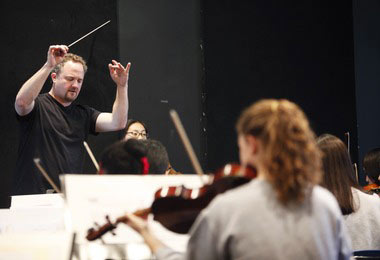
14 Oct Leader of the band – Artistic director of the New Jersey Youth Symphony finds that his place is guiding young musicians
Jeffrey Grogan raises a tight fist and his biceps bulge. His face reddens as teenage string players unfurl a rapid descending scale, and then a chorus of winds and brasses fills a classroom on the Rutgers Newark campus.
“If you rush,” Grogan sighs and pauses dramatically, “we’re dead.”
“Ever watch those cartoons where you follow the bouncing ball? If you follow my baton, I will guide you to safety.”
Grogan is the guide for hundreds of young musicians in and around New Jersey every year. As education and community engagement conductor of the New Jersey Symphony Orchestra, he leads the NJSO’s youth outreach arm, the Greater Newark Youth Orchestra.
Besides the youth orchestra, he is music director of the New Jersey Youth Symphony and artistic director of the Interschool Orchestras of New York, with whom he sold out Carnegie Hall this year — and raised $250,000 in one night.
In addition to these positions, he has a thriving career as a guest conductor for student and professional orchestras around the country
“I enjoy my time with the big orchestra,” he says, referring to the NJSO. “That scratches my artistic itch, but, really, this is what I love.”
“Jeff has the combination of being a very good conductor and knowing exactly how to get through to these young people and be a part of the team,” says former NJSO president André Gremillet (who left his post this summer after five years of working with Grogan).
“He’s a born communicator.”
At the rehearsal, as Tchaikovsky blares, a bassist in neon argyle shorts bends his knees and swings his hips. It’s an early Saturday morning, but over the course of three hours, an observer can see only one quick peek at a phone, only one yawn.
“Imagine there’s a dartboard,” Grogan says. “You’re hitting the target, but you’re happy with 20 or 40 points. You want that 100 point bulls-eye.”
‘Star wars’ inspiration
The piece of music that changed Grogan’s life? It wasn’t Beethoven. Or Bach. Or Mozart.
“For me, it was ‘Star Wars,’ in 1977,” Grogan says.
He was in fourth grade when his parents bought him the two-record set with the now-iconic compositions of John Williams, so he could relive the movie. He listened for hours every night and eventually, without prompting, he started to conduct the music.
When it came time to join the school band two years later, inspired by the bold brass sounds, he wrote down “trumbone” (with a “u”) as his instrument of choice. He later switched to the French horn.
“That was my tie in to classical music, and then I heard Holst and then I heard Shostakovich and Mahler.”
Grogan grew up in Cedar Hill, Texas. As he says with a slight twang, “we had cows, a water tower and a Dairy Queen.” A career in classical music seemed foreign, and when he received his bachelor’s degree in music education at Stephen F. Austin State University, all he wanted to do was lead a Texas high school band to first place in competitions.
But his college band director, who was “like a dad away from home,” suggested that maybe he could do something more. Grogan went on to receive his master’s degree in conducting from the University of Michigan.
Grogan has paid the advice forward with a woman he worked with at the Indiana State University Drum Major Clinic. She was a shy young woman who did not believe she could ever be good enough to become a professional musician, but Grogan saw her talent and nurtured it.
Sarah Kidd is one of very few students to whom Grogan has said, “You’ve got what it takes to be a big-time orchestra conductor.”
She now has a master’s degree in conducting from the Juilliard School and has been the assistant conductor of the New York Youth Symphony. She stayed with Grogan and his wife at their house in Nutley before for her Juilliard audition.
“Getting in to Juilliard was a dream come true, and I owe so much to Mr. Grogan for helping me along the way,” she says. “He believed in me, and I learned to believe in myself. That’s what gave me the courage to pursue a career in music.”
striking the right tone
The French horn doesn’t create an “instant genius” like “Guitar Hero” does, and an orchestra doesn’t come together with the ease of a group of “Rock Band” players.
As Grogan points out, “When you first start an instrument, it’s hard to imagine you can ever make the sound a professional does, because it sounds so horrible at the beginning.”
So what’s the formula for an ambassador of the classics? What kind of alchemy is Grogan practicing?
“Usually, it’s all in picking the right repertoire,” he says.
“First, a piece they can play immediately and sound good on, so we can work on details and build the chemistry of the group. Then, a piece they’re going to have to really work at and then something in the middle.”
Usually, he starts with something romantic, like the Tchaikovsky, so that students can tap into the passionate, heart-on-the-sleeve quality. Selling it might mean telling kids to imagine the most difficult time they’ve been through, or to let out any frustration they’re feeling.
“When I started teaching, it was all technique-based, and kids check out,” he says.
“The way I describe music now, I try to attach something about emotion to every technical recipe.”
As Greater Newark Youth Orchestra student Lynn Padmore puts it, “He’s the only conductor I know that uses death, destruction and annihilation for his analogies and suggestions — it’s really funny.”
Padmore, 18, who played the flute with the youth orchestra for nine years, is a recent graduate of Cicely Tyson High School in East Orange. With no orchestra at school, she says that playing with the ensemble opened up a whole new world to her — and is the reason she is pursuing music in college at Bucknell University.
Grogan tells stories about composers and encourages students to relate the music to events in their lives.
As a contrast to their current leader, Padmore and her fellow musicians describe previous conductors at school or in other orchestras who would speak in riddles, gesticulate incomprehensibly or launch into long, rambling tirades. One even threw a baton.
Even for New Jersey’s resident youth conductor, striking the right tone is a challenge. Watching him, there’s a mixture of elevated maestro and a friend who’s on the students’ level.
Before pursuing full-time conducting, Grogan taught in Texas public schools, then he spent 12 years teaching college students at the University of Michigan and Ithaca College. Drawing in part on those experiences, he saves his most enthusiastic moments of praise for the minute something locks in just right.
“The ultimate trust of a student is for their teacher to be honest with them,” he says.
“Some of the kids like it when you say, ‘Do this!’ ” he barks, slapping his hands together as though he were a strict teacher rapping a ruler against a desk.
“Then, if they have a certain vibe with you, a certain level of respect, you can ask them for what you want and get more results.”
“But if I do that all the time, it doesn’t work. Kids are interesting beings.”
galvanized efforts
Besides the difficulty of capturing his students’ attention, for each ensemble with which Grogan works, he faces a climate in which orchestras across the country are struggling. As arts education programs in schools are cut, the role of ensembles such as the Newark youth orchestra and the New Jersey Youth Symphony can be more pivotal to students than ever, but fundraising and setting an organizational agenda are industry-wide challenges.
When Grogan came on board at the New Jersey Youth Symphony, says executive director Derek Mithaug, it was “a very contentious time.”
“Since 2008, it’s been very difficult for these kinds of youth organizations to stay afloat,” he says. “It takes a lot of work and there’s not much financial support for qualified people to do that work.”
“What you need is someone to come in and rally everyone together, and then you need that personality to attract really qualified staff.”
Two new staff members joined the ensemble under Grogan’s leadership, and this summer, he accompanied students to Vienna to play at the historic Musikverein, where Johannes Brahms once performed. This year, based on the board’s approval, he was promoted from music director to artistic director.
“For quite a while, it was uncertain how the organization would continue on its current course,” Mithaug says. “When Jeff stepped on board, it seemed to kind of galvanize everyone — donors started coming out, parents started stepping forward. It had an immense impact on the overall institution.”
musical connection
When Janice Chun plays the solo part of Mendelssohn’s violin concerto, she gets shivers down her spine. Chun, 14, just graduated from Tenafly Middle School and was the Greater Newark Youth Orchestra concertmaster last season.
“The whole orchestra is booming,” she says. “It’s like a conversation, almost like my violin is speaking to them.”
The concerto, which Chun performed in June, was her first. Grogan took her aside during rehearsals to ask how life was going, and made her feel comfortable with the daunting task.
“The best thing is putting your small part into a whole mesh of other parts and just making one piece of music sound perfect,” says Daniel Minogue, an 18-year-old trumpet player from Plainfield.
“It’s a new way of connecting. … you become one.”
“Music’s the ultimate kid magnet,” Grogan says. “It pulls them together — they don’t have to talk, they can just do this and all communicate.”
Grogan travels often for his various gigs, and a month can go by without a single day off. Between rehearsals, he’s at the airport. Some days, it’s tough; some days are overwhelming.
But if that’s the case when he’s leading the youth orchestra at this rehearsal, it doesn’t show. By the time the rehearsal ends, those bulls-eyes have been hit, annihilation has been avoided, the horn players and violinists have started to pack up their cases — and Grogan has just one desire.
“I wish we had six more hours!” he says.
Ronni Reich: (973) 392-1726, rreich@starledger.com, Twitter: @RonniReich
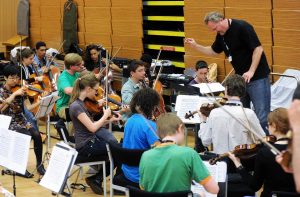
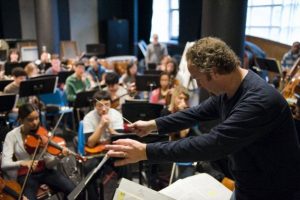
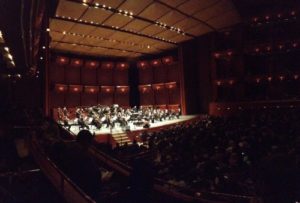
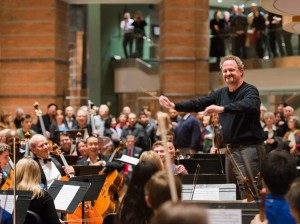
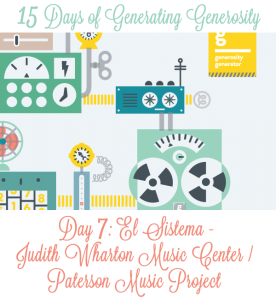
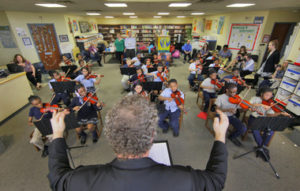
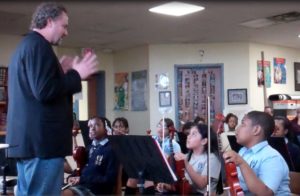
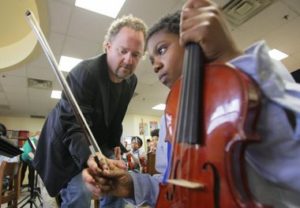
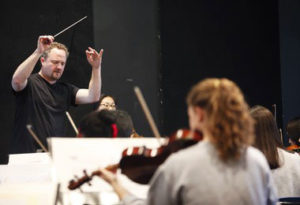
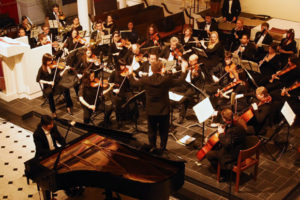
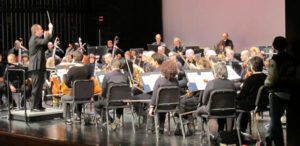
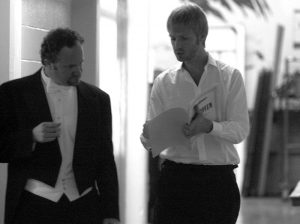
No Comments